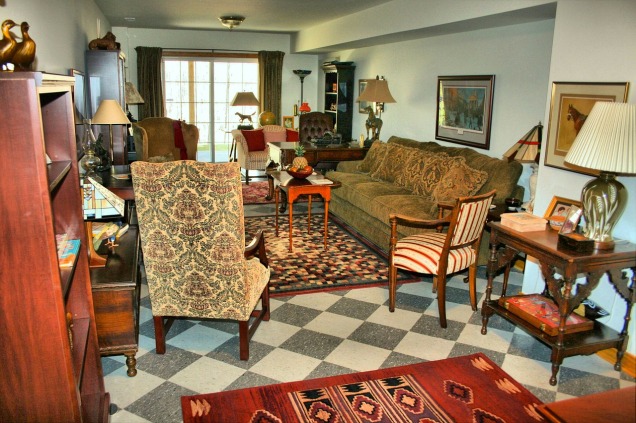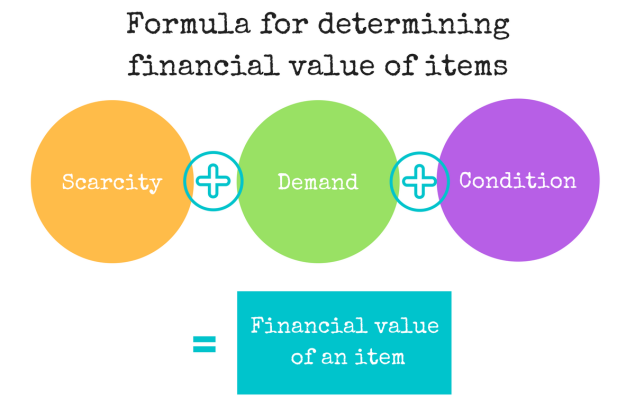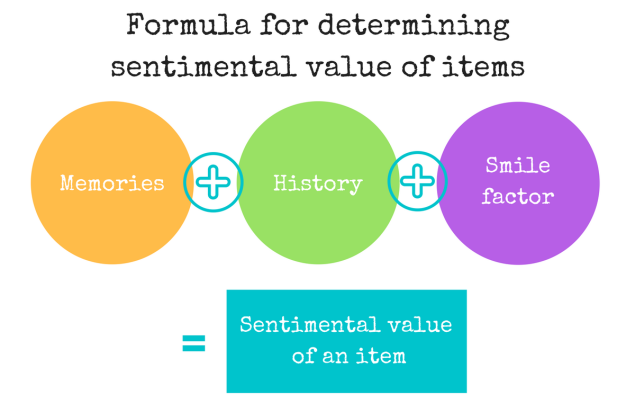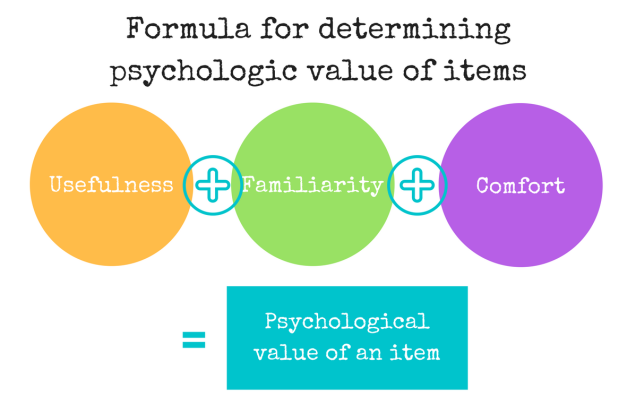
That’s a good question. And one that almost everyone making a downsizing transition asks. Like most things in life, there isn’t a black and white answer. But, really, what is your stuff worth, and how do you find out?
Lots of things have worth or value. That value is almost entirely unrelated to the purchase price. Value is something determined in real time. The value of stuff can change dramatically from year to year, decade to decade. The thing itself hasn’t changed, but it’s value has. How inconvenient! But ahhhh, how true.
There are three kinds of value: financial, sentimental or psychological. And while you have limited control over financial value, you have lots of power to determine the sentimental or psychological value of things. Let’s look at why:
Financial Value
The financial value of an item is what someone is willing to pay for it. Here’s the formula:

It’s a little like alchemy. Things that there are fewer of, that are in good condition and that are in demand are worth more financially than things there are abundant quantities of that aren’t as desired.
Things that are scarce are things that might have been sent to the thrift store or the landfill (oh the horror!) years ago because they weren’t viewed as “valuable.” (Translation: they didn’t cost very much.) Some examples: supermarket china in good condition is often more valuable than fine china, vintage cookbooks and children’s books that are out of print are often more prized than new books, old blue jeans are usually more valuable on a resale market than new ones. Since there are fewer of those items around and there is demand for them, the price is higher if you are selling them.
Things that were costly when you bought them, like dining room tables, hutches and upholstered furniture, are often donations because the market is currently saturated with them. The well-worn basement workbench with a good vintage patina is probably worth more at resale than the dining room table. (Of course, the workbench wouldn’t go back to the cellar, it would more likely become a piece of furniture in a rustic cottage home.) Furniture tastes have changed. 1980s style furniture, for example, is not in high demand. Exceptions are signed design pieces and trend design pieces. It’s hard to stay up on what’s popular—many clients are surprised to find out that Lucite and acrylic pieces from the 1970s and 1960s Italian gesso Florentine pieces are both is having a renaissance and are in demand.
Sentimental Value
There are no pricing guides for sentimental value, you can’t slap a ruler on it to measure its size and you can’t calculate the ROI for keeping it or letting it go. All you can know is it means a great deal to you. How much does it mean, here’s our formula:

To break it down, the sentimental value lies in the memories an object holds, the history of where it came from and how happy it makes you when you see it. If when you sit at your writing desk, you can see your mom sitting there and she could see her mom sitting there, that piece is dripping in lovely sentimental value. The same is often true for kitchenware and china, clocks, photos and scrapbooks, and art.
Things that mark milestones like diplomas and anniversary plates might have virtually no sentimental value. The event was important, the ephemera associated with it is not. But a kindergarten report card? Hard to replace, highly sentimental.
The next generation may not have high sentimental value for things that you adore. But just like you did when you were younger, they have formed their own sentimental attachments to things that were part of their life.
Psychological Value
Things with high psychological value are not wrapped in memories, nor are they unusually valuable. They are things that make your life better. They may not be as bright and shiny as when you first got them, but they have form and function to get you through the day. Here’s how to analyze that:

These are things that are useful, in that they are used regularly. They are familiar—you know how they work and how best to use them. And they provide a level of comfort in their predictability. Things that fit into the category of high psychological value are your favorite coffee cup, your chair and side table, your favorite pots and pans and perhaps your small electronics like your clock or a radio.
When you’re making a move, there are those that might encourage you to replace those things with things that are newer, because they are probably showing their age. But if these are things that make every day better for you, you can almost always find a way to make them a part of your new nest.
♦ ♦ ♦ ♦ ♦ ♦ ♦ ♦
So what are things worth? At the end of the day, you bought things to use them. If they have some resale value now, that is a bonus. You bought them, you used them, you are getting something back. And those things will probably not be the things you are expecting them to be. But the things that have the most worth to you are those with sentimental and psychological value. Those are the things that are too valuable to put a price on.
